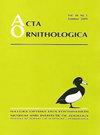Autumn Migration Strategy and Stop-Over Sites of the Globally Threatened Aquatic Warbler Acrocephalus paludicola on the Atlantic Flyway Migration Route
IF 1.3
4区 生物学
Q3 ORNITHOLOGY
引用次数: 0
Abstract
Abstract. Knowledge about migration strategy and availability of stop-over sites of globally threatened migratory birds is crucial for the implementation of efficient conservation plan. In this study, we investigated the refuelling strategy of the globally threatened Aquatic Warbler Acrocephalus paludicola at stop-over sites during the autumn migration in West Europe and Africa (40 and 72 sites, respectively, documented in published works about stop-over ecology and sites). Based on fuel reserves of captured birds we calculated potential maximal range of non-refuelling flight from stop-over sites located on the Atlantic flyway migration route. We tried to verify the hypothesis that Aquatic Warblers are able to cross the Sahara during one non-stop flight. We found that mean range of flights was affected significantly by the stopover geographic location but not by age of the birds and stop-over habitat. Individuals staging in France are able to cover smaller distances (mean 612.7 km) compared to individuals staging in Portugal and Spain (mean 857.5 km), i.e. closer to two important geographical barriers (the Gibraltar Strait and the Sahara desert). However, maximal ranges of the heaviest individuals were longer (2370 km in France and 1998 km in Portugal). Our study suggests that Aquatic Warblers are generally not able to cross the Sahara during one non-stop flight. Only some individuals with high fat loads starting from stop-overs in Portugal may be able to cross the Sahara without refuelling. However, due to diel air temperature pattern in the desert they need to stop at least once to rest and wait for nighttime drop in temperature to continue migration. Within the Sahara there are many small patches of suitable habitats which can facilitate resting and maybe even refuelling. Observed and predicted reduction of available area of stop-over habitats may have serious negative consequences for population dynamics of many land-bird species, including the globally threatened Aquatic Warbler.全球濒危水生莺在大西洋迁徙路线上的秋季迁徙策略和中途停留点
摘要了解迁徙策略和全球受威胁候鸟中途停留点的可用性对于实施有效的保护计划至关重要。在这项研究中,我们调查了在西欧和非洲秋季迁徙期间,受全球威胁的水生莺Acrochalus paludicola在中途停留地点的补给策略(分别有40个和72个地点,记录在已发表的关于中途停留生态学和地点的著作中)。根据捕获鸟类的燃料储备,我们计算了从大西洋航线迁徙路线上的停靠点起飞的不加油飞行的潜在最大范围。我们试图验证水生莺能够在一次不间断飞行中穿越撒哈拉的假设。我们发现,平均飞行范围受中途停留地理位置的显著影响,但不受鸟类年龄和中途停留栖息地的影响。与在葡萄牙和西班牙集结的个人(平均857.5公里)相比,在法国集结的个人能够覆盖更小的距离(平均612.7公里),即更靠近两个重要的地理屏障(直布罗陀海峡和撒哈拉沙漠)。然而,最重个体的最大射程更长(法国为2370公里,葡萄牙为1998公里)。我们的研究表明,水生莺通常无法在一次不间断的飞行中穿越撒哈拉沙漠。只有一些在葡萄牙停留时脂肪含量高的人才能在不加油的情况下穿越撒哈拉沙漠。然而,由于沙漠中的昼夜气温模式,它们需要至少停下来休息一次,等待夜间气温下降才能继续迁徙。撒哈拉沙漠中有许多小块合适的栖息地,可以方便休息,甚至可以加油。观察到和预测到的停歇栖息地可用面积的减少可能会对许多陆地鸟类的种群动态产生严重的负面影响,包括受到全球威胁的水生莺。
本文章由计算机程序翻译,如有差异,请以英文原文为准。
求助全文
约1分钟内获得全文
求助全文
来源期刊

Acta Ornithologica
生物-鸟类学
CiteScore
2.10
自引率
0.00%
发文量
14
审稿时长
>12 weeks
期刊介绍:
Publishes scientific papers (original research reports, reviews, short notes, etc.) and announcements from all fields of ornithology. All manuscripts are peer-reviewed.
Established in 1933 as Acta Ornithologica Musei Zoologici Polonici, since 1953 continued under the present title.
Published twice a year by the Natura Optima Dux Foundation under the auspices of the Museum and Institute of Zoology, Polish Academy of Sciences.
 求助内容:
求助内容: 应助结果提醒方式:
应助结果提醒方式:


